Abstract
Cryostat sections of fifteen full-term, normal, human placentae have been studied by indirect immunofluorescence, using characterized antisera to a large number of proteins, in order to localize particular protein antigens to well-defined anatomical regions. Actin, plasminogen, and transferrin were identified in trophoblasts. Beta-2-microglobulin was uniformly absent from these cells. The complement component C3, the immunoglobulin IgG, and fibrinogen and collagen were identified in trophoblastic basement membranes. Of these IgG was the most sparingly represented, and C3 was not found on all trophoblastic basement membranes. Many proteins were identified within the stroma of chorionic billi, collagen being the most abundant. Many of these persisted following prolonged washing of the tissues.All four IgG subclasses were present in stroma, IgG1 and IgG3 being most prominent. Stromal cells were positive for beta-2-microglobulin, suggesting a unique sequestration of this protein on stromal cells but not on trophoblasts. Placental stem vessels were surrounded by collagen, and the walls of these vessels stained brightly for myosin: the vascular endothelium contained beta-2-microglobulin and actin. Peri- and inter-villous fibrin were faintly positive for several proteins, but these areas stained intensely for fibrinogen, plasminogen, alpha-2-macroglobulin and C4. This approach has proven to be useful in establishing precise definitions of the molecular morphology of normal human placentae.
Full text
PDF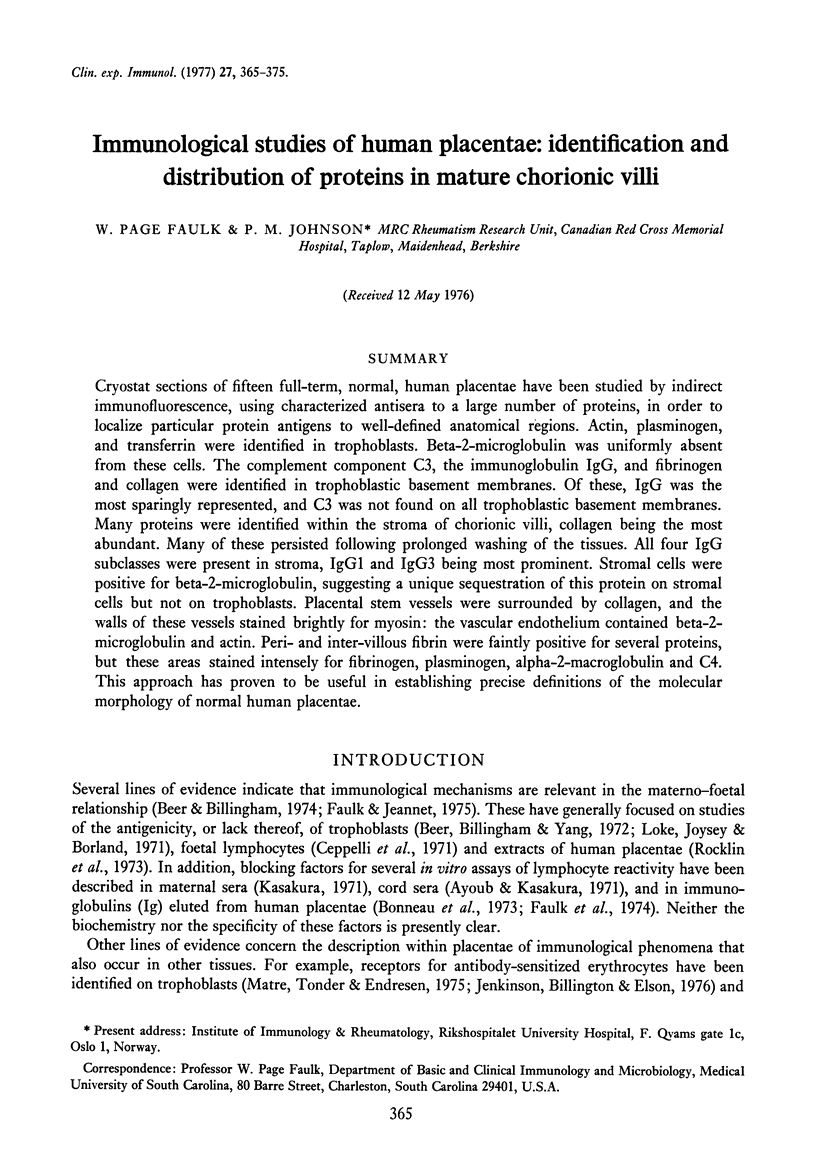
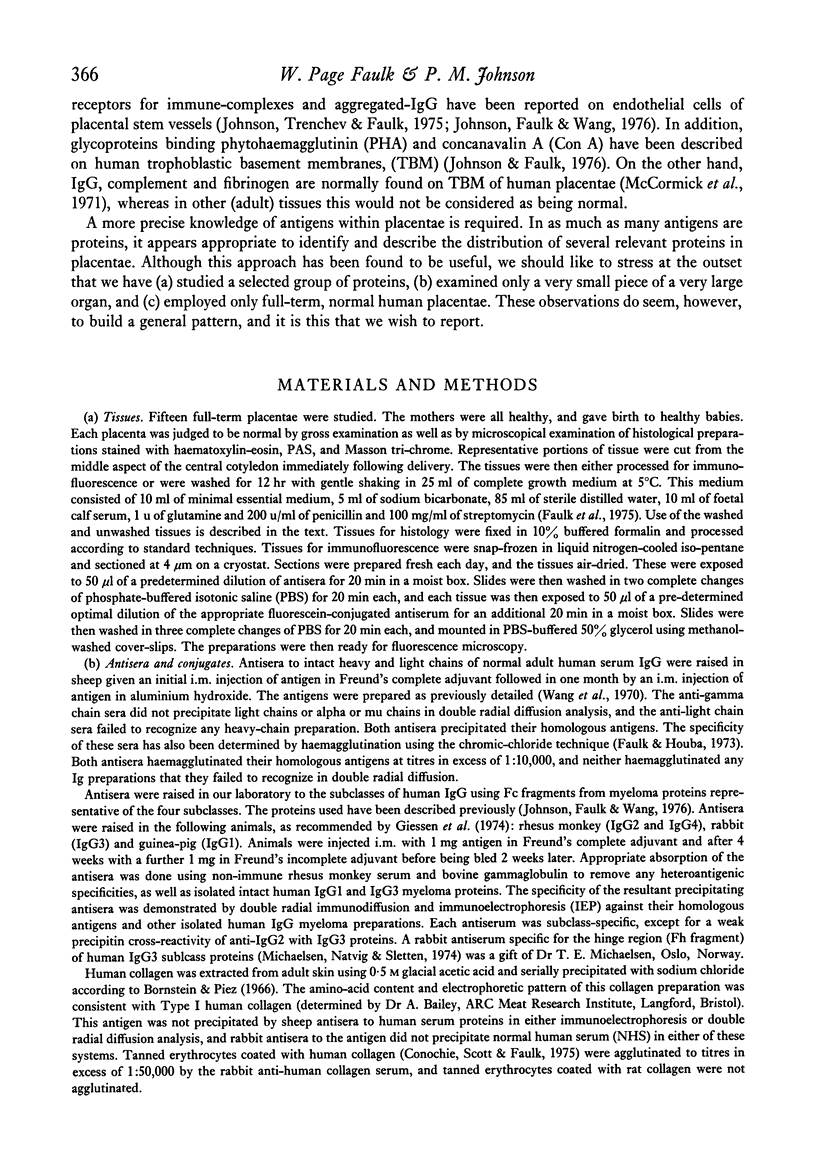
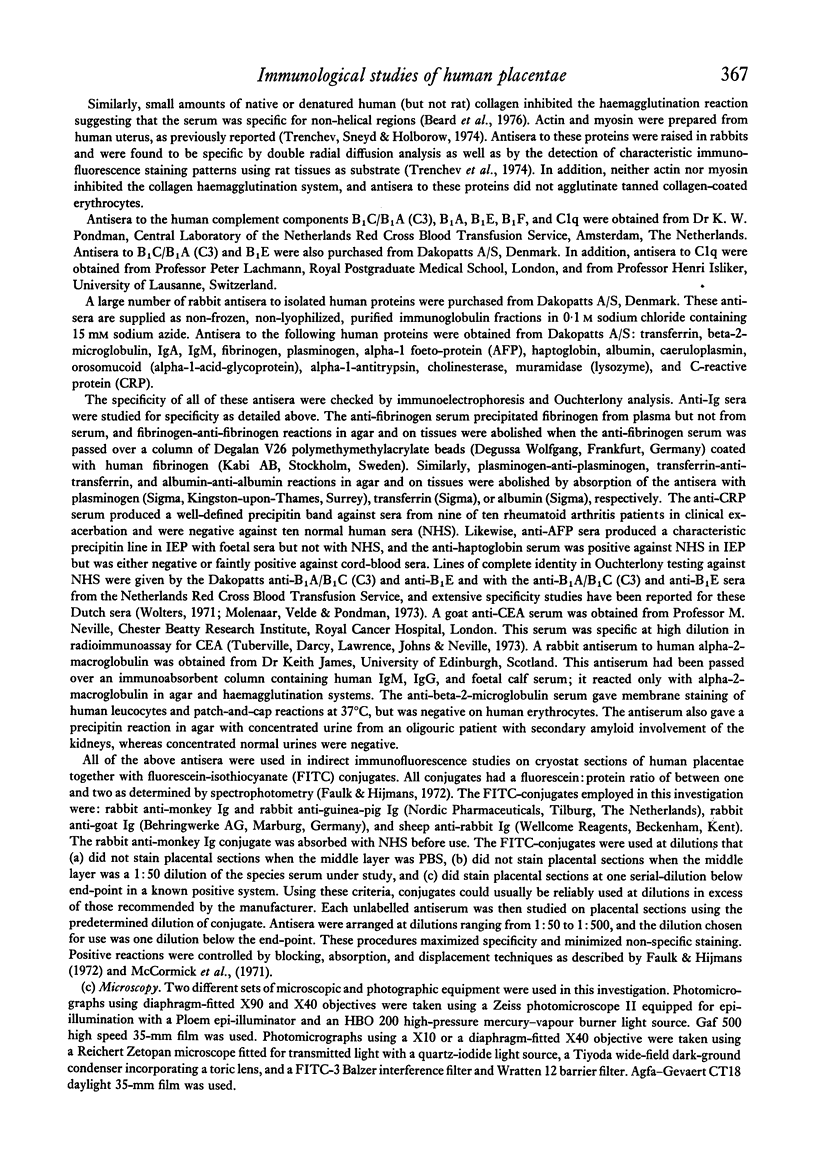
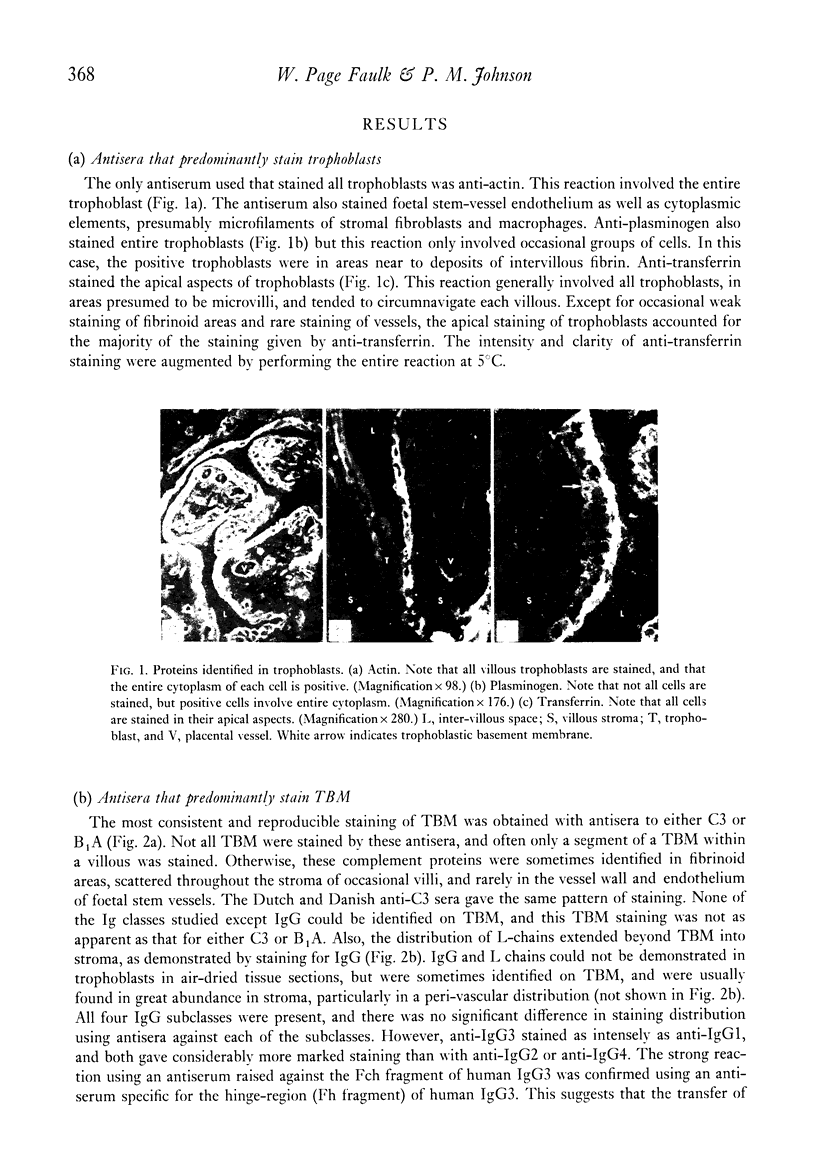
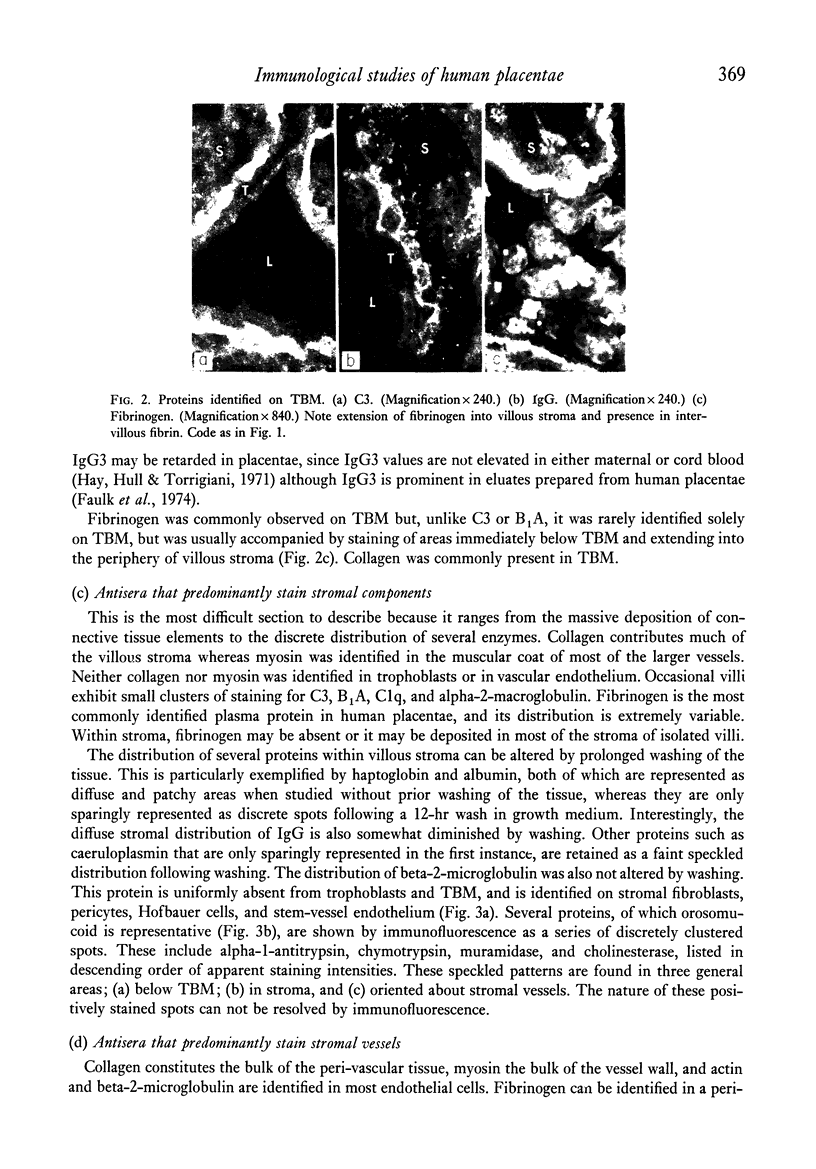
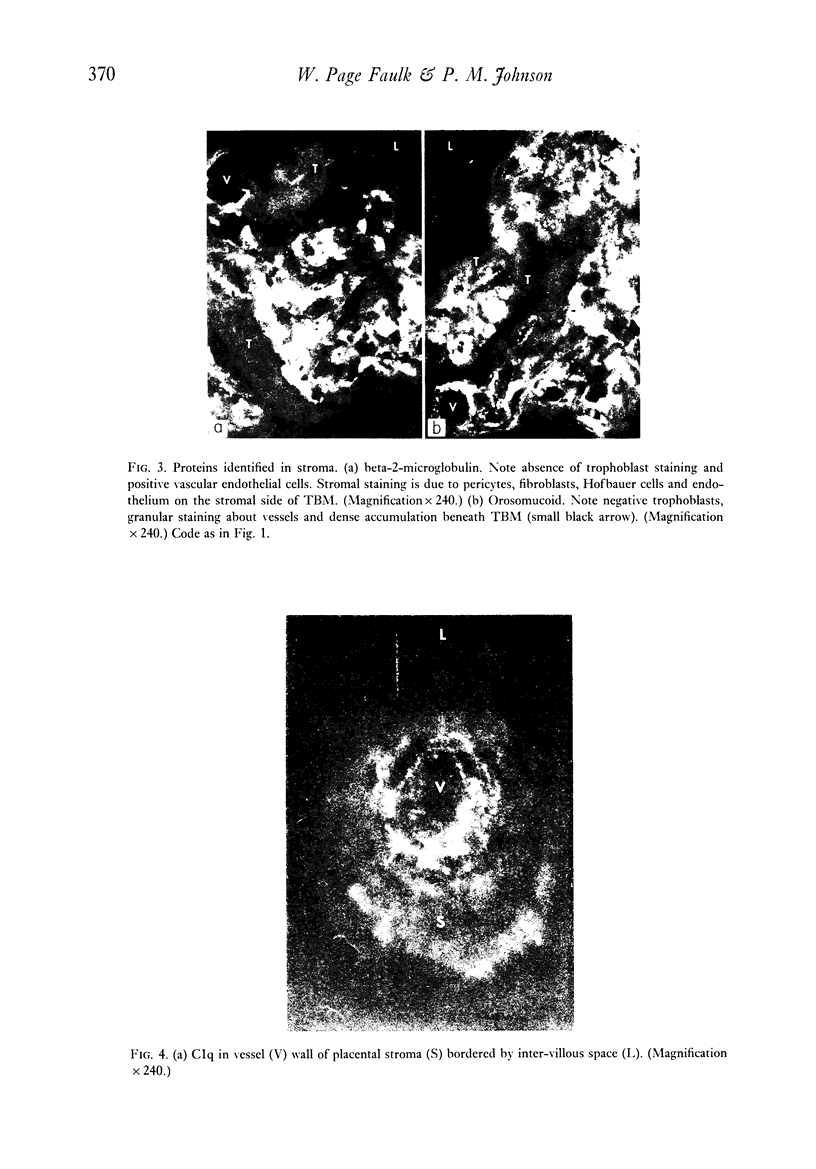
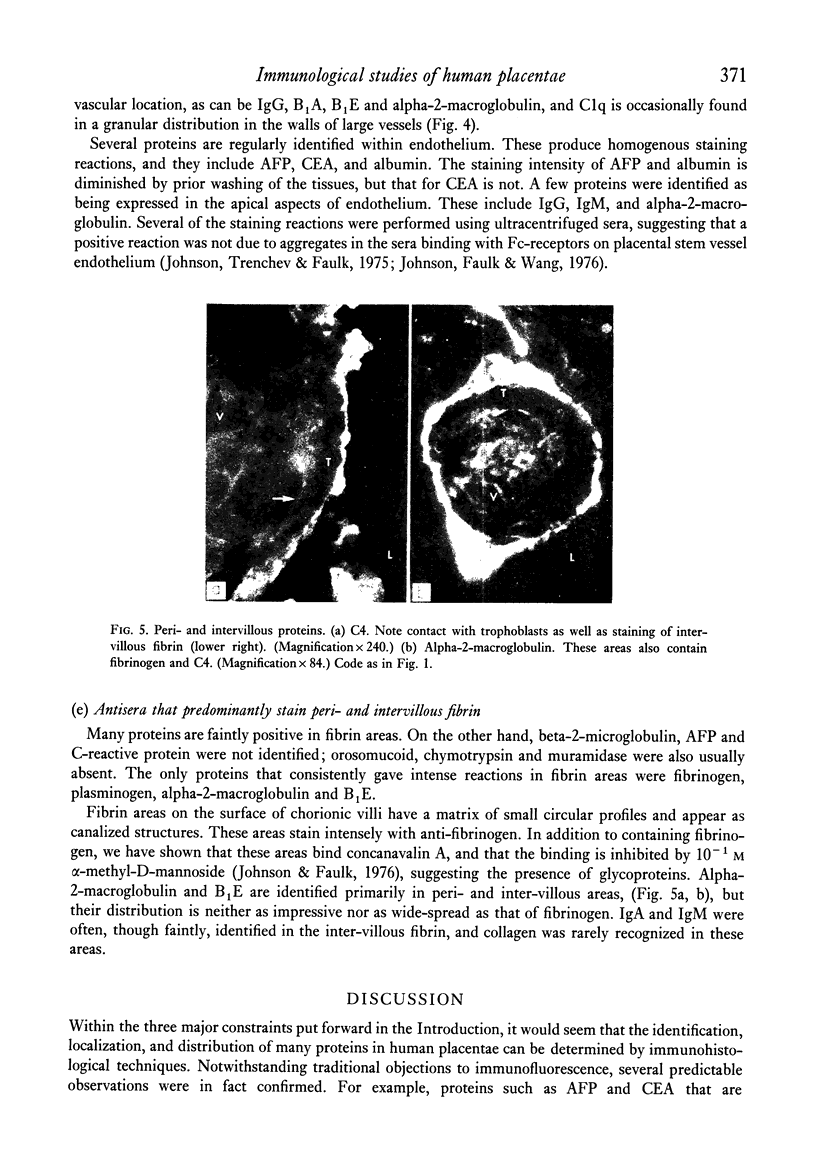
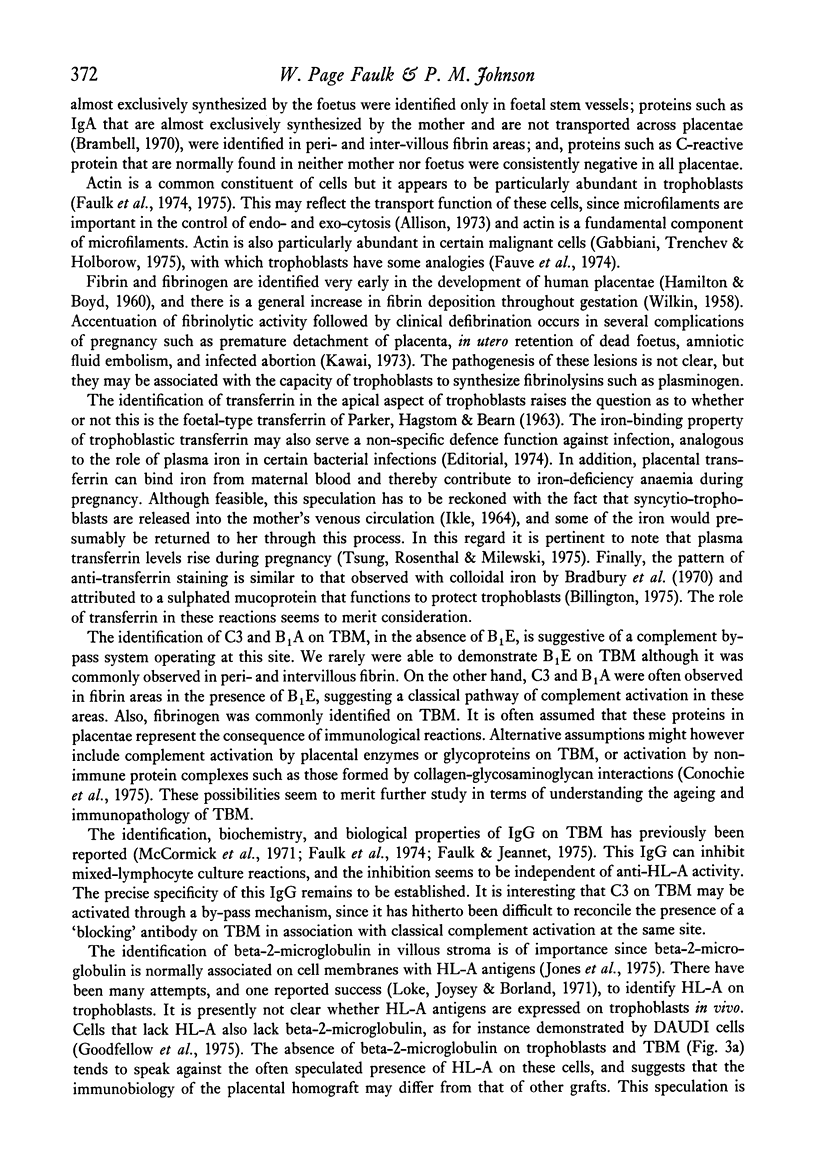
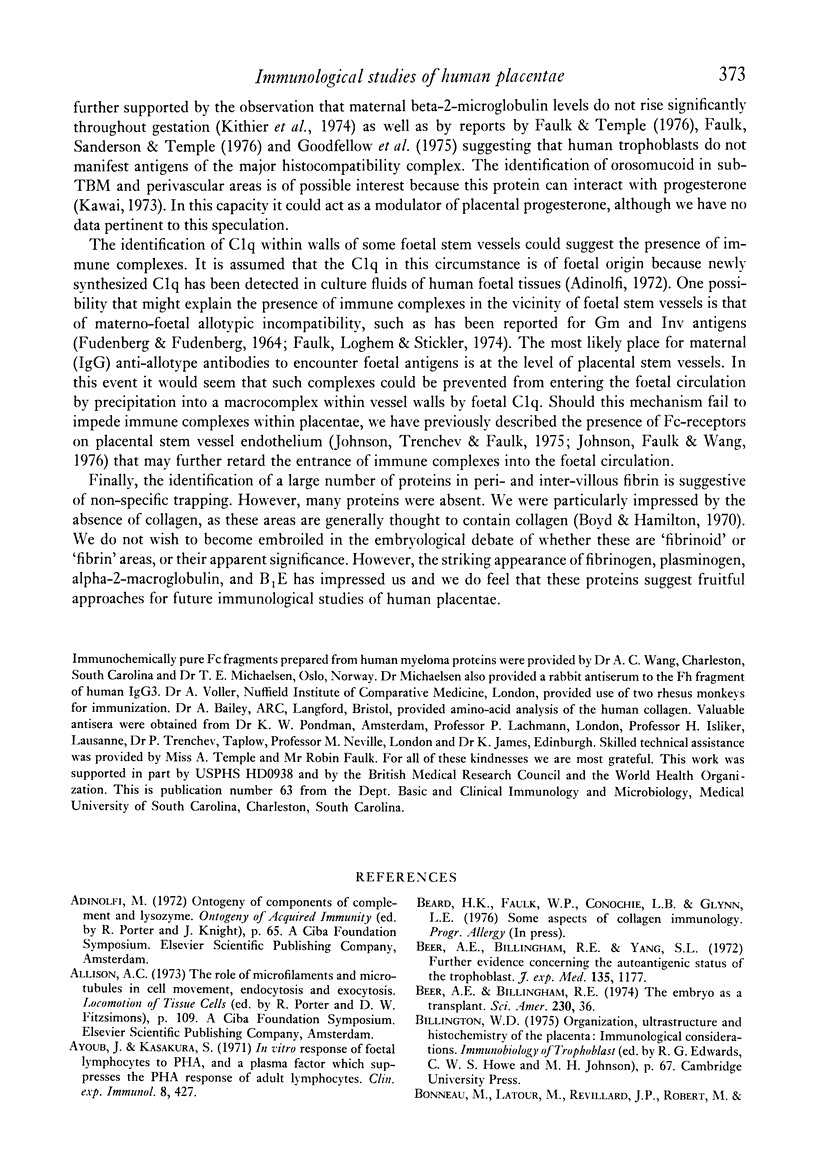
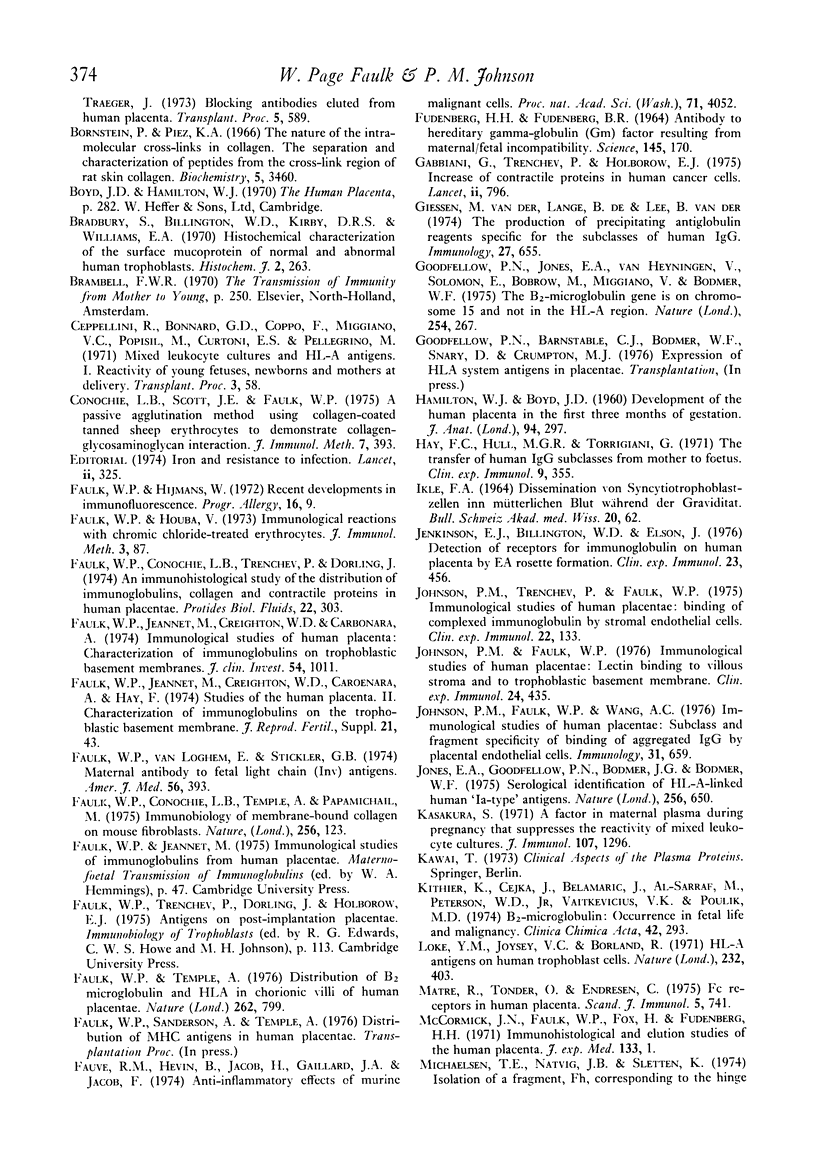
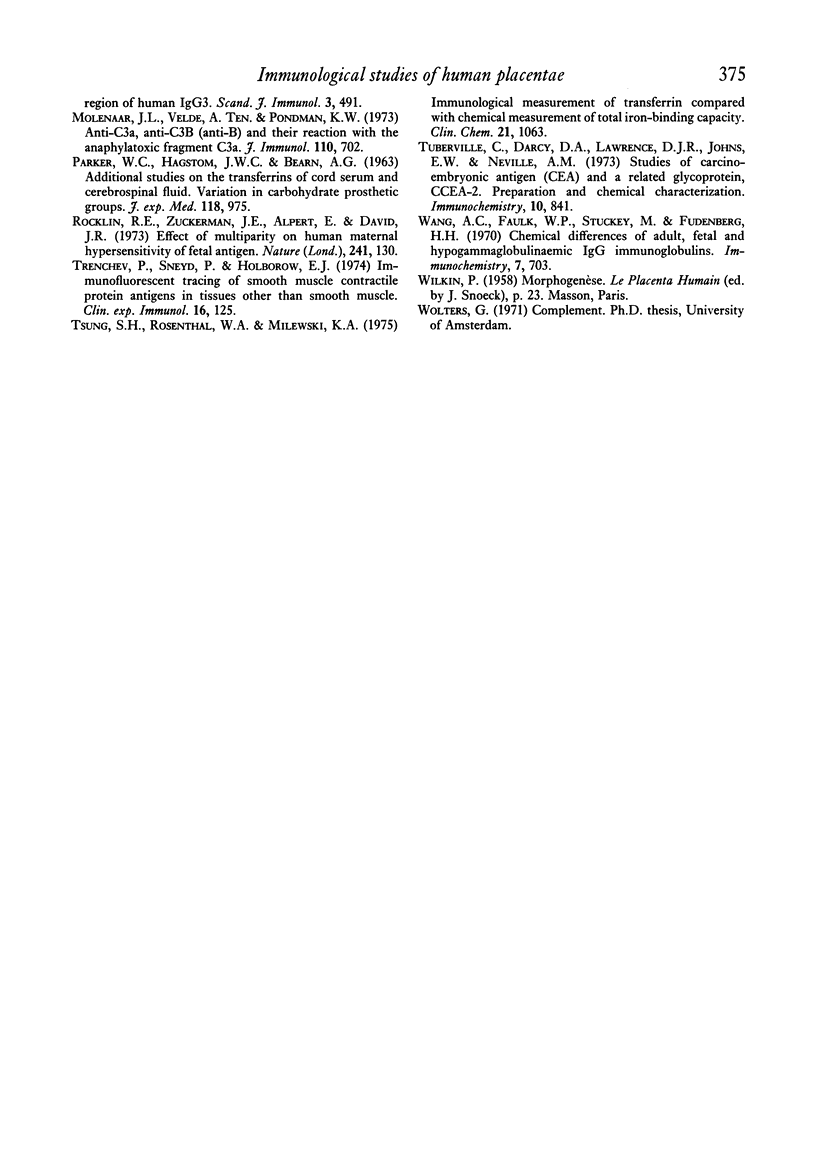
Images in this article
Selected References
These references are in PubMed. This may not be the complete list of references from this article.
- Allison A. C. The role of microfilaments and microtubules in cell movement, endocytosis and exocytosis. Ciba Found Symp. 1973;14:109–148. doi: 10.1002/9780470719978.ch6. [DOI] [PubMed] [Google Scholar]
- Ayoub J., Kasakura S. In vitro response of foetal lymphocytes to PHA, and a factor plasma which suppresses the PHA response of adult lymphocytes. Clin Exp Immunol. 1971 Mar;8(3):427–434. [PMC free article] [PubMed] [Google Scholar]
- Beer A. E., Billingham R. E. The embryo as a transplant. Sci Am. 1974 Apr;230(4):36–46. doi: 10.1038/scientificamerican0474-36. [DOI] [PubMed] [Google Scholar]
- Beer A. E., Billingham R. E., Yang S. L. Further evidence concerning the autoantigenic status of the trophoblast. J Exp Med. 1972 May 1;135(5):1177–1184. doi: 10.1084/jem.135.5.1177. [DOI] [PMC free article] [PubMed] [Google Scholar]
- Bonneau M., Latour M., Revillard J. P., Robert M., Traeger J. Blocking antibodies eluted from human placenta. Transplant Proc. 1973 Mar;5(1):589–592. [PubMed] [Google Scholar]
- Bornstein P., Piez K. A. The nature of the intramolecular cross-links in collagen. The separation and characterization of peptides from the cross-link region of rat skin collagen. Biochemistry. 1966 Nov;5(11):3460–3473. doi: 10.1021/bi00875a012. [DOI] [PubMed] [Google Scholar]
- Bradbury S., Billington W. D., Kirby D. R., Williams E. A. Histochemical characterization of the surface mucoprotein of normal and abnormal human trophoblast. Histochem J. 1970 Jul;2(4):263–274. doi: 10.1007/BF01004995. [DOI] [PubMed] [Google Scholar]
- Ceppellini R., Bonnard G. D., Coppo F., Miggiano V. C., Pospisil M., Curtoni E. S., Pellegrino M. Transplantation antigens: introductory symposium. Mixed leukocyte cultures and HL-A antigens. I. Reactivity of young fetuses, newborns and mothers at delivery. Transplant Proc. 1971 Mar;3(1):58–63. [PubMed] [Google Scholar]
- Conochie L. B., Scott J. E., Faulk W. P. A passive agglutination method using collagen-coated tanned sheep erythrocytes to demonstrate collagen-glycosaminoglycan interaction. J Immunol Methods. 1975 Jul;7(4):393–397. doi: 10.1016/0022-1759(75)90048-4. [DOI] [PubMed] [Google Scholar]
- FUDENBERG H. H., FUDENBERG B. R. ANTIBODY TO HEREDITARY HUMAN GAMMA-GLOBULIN (GM) FACTOR RESULTING FROM MATERNAL-FETAL INCOMPATIBILITY. Science. 1964 Jul 10;145(3628):170–171. doi: 10.1126/science.145.3628.170. [DOI] [PubMed] [Google Scholar]
- Faulk W. P., Conochie L. B., Temple A., Papamichail M. Immunobiology of membrane-bound collagen on mouse fibroblasts. Nature. 1975 Jul 10;256(5513):123–125. doi: 10.1038/256123a0. [DOI] [PubMed] [Google Scholar]
- Faulk W. P., Jeannet M., Creighton W. D., Carbonara A. Immunological studies of the human placenta. Characterization of immunoglobulins on trophoblastic basement membranes. J Clin Invest. 1974 Nov;54(5):1011–1019. doi: 10.1172/JCI107844. [DOI] [PMC free article] [PubMed] [Google Scholar]
- Faulk W. P., Temple A. Distribution of beta2 microglobulin and HLA in chorionic villi of human placentae. Nature. 1976 Aug 26;262(5571):799–802. doi: 10.1038/262799a0. [DOI] [PubMed] [Google Scholar]
- Faulk W. P., van Loghem E., Stickler G. B. Maternal antibody to fetal light chain (Inv) antigens. Am J Med. 1974 Mar;56(3):393–397. doi: 10.1016/0002-9343(74)90621-4. [DOI] [PubMed] [Google Scholar]
- Fauve R. M., Hevin B., Jacob H., Gaillard J. A., Jacob F. Antiinflammatory effects of murine malignant cells. Proc Natl Acad Sci U S A. 1974 Oct;71(10):4052–4056. doi: 10.1073/pnas.71.10.4052. [DOI] [PMC free article] [PubMed] [Google Scholar]
- Gabbiani G., Trenchev P., Holborow E. J. Increase of contractile proteins in human cancer cells. Lancet. 1975 Oct 25;2(7939):796–797. doi: 10.1016/s0140-6736(75)80008-0. [DOI] [PubMed] [Google Scholar]
- Goodfellow P. N., Jones E. A., Van Heyningen V., Solomon E., Bobrow M., Miggiano V., Bodmer W. F. The beta2-microglobulin gene is on chromosome 15 and not in the HL-A region. Nature. 1975 Mar 20;254(5497):267–269. doi: 10.1038/254267a0. [DOI] [PubMed] [Google Scholar]
- HAMILTON W. J., BOYD J. D. Development of the human placenta in the first three months of gestation. J Anat. 1960 Jul;94:297–328. [PMC free article] [PubMed] [Google Scholar]
- Hay F. C., Hull M. G., Torrigiani G. The transfer of human IgG subclasses from mother to foetus. Clin Exp Immunol. 1971 Sep;9(3):355–358. [PMC free article] [PubMed] [Google Scholar]
- IKLE F. A. DISSEMINATION VON SYNCYTIOTROPHOBLASTZELLEN IM MUETTERLICHEN BLUT WAEHREND DER GRAVIDITAET. Bull Schweiz Akad Med Wiss. 1964 Mar;20:62–72. [PubMed] [Google Scholar]
- Jenkinson E. J., Billington W. D., Elson J. Detection of receptors for immunoglobulin on human placenta by EA rosette formation. Clin Exp Immunol. 1976 Mar;23(3):456–461. [PMC free article] [PubMed] [Google Scholar]
- Johnson P. M., Faulk W. P. Immunological studies of human placentae. Lectin binding to villous stroma and to trophoblastic basement membrane. Clin Exp Immunol. 1976 Jun;24(3):435–440. [PMC free article] [PubMed] [Google Scholar]
- Johnson P. M., Faulk W. P., Wang A. C. Immunological studies of human placentae: subclass and fragment specificity of binding of aggregated IgG by placental endothelial cells. Immunology. 1976 Oct;31(4):659–664. [PMC free article] [PubMed] [Google Scholar]
- Johnson P. M., Trenchev P., Faulk W. P. Immunological studies of human placentae. Binding of complexed immunoglobulin by stromal endothelial cells. Clin Exp Immunol. 1975 Oct;22(1):133–138. [PMC free article] [PubMed] [Google Scholar]
- Kithier K., Cejka J., Belamaric J., Al-Sarraf M., Peterson W. D., Jr, Vaitkevicius V. K., Poulik M. D. Beta2-microglobulin: occurrence in fetal life and malignancy. Clin Chim Acta. 1974 May 17;52(3):293–299. doi: 10.1016/0009-8981(74)90113-2. [DOI] [PubMed] [Google Scholar]
- Loke Y. W., Joysey V. C., Borland R. HL-A antigens on human trophoblast cells. Nature. 1971 Aug 6;232(5310):403–405. doi: 10.1038/232403a0. [DOI] [PubMed] [Google Scholar]
- Matre R., Tönder O., Endresen C. Fc receptors in human placenta. Scand J Immunol. 1975;4(7):741–745. doi: 10.1111/j.1365-3083.1975.tb02682.x. [DOI] [PubMed] [Google Scholar]
- McCormick J. N., Faulk W. P., Fox H., Fudenberg H. H. Immunohistological and elution studies of the human placenta. J Exp Med. 1971 Jan 1;133(1):1–18. doi: 10.1084/jem.133.1.1. [DOI] [PMC free article] [PubMed] [Google Scholar]
- Molenaar J. L., ten Velde A., Pondman K. W. Anti-C3a, anti-C3B (anti-B) and their reaction with the anaphylatoxic fragment C3a. J Immunol. 1973 Mar;110(3):702–708. [PubMed] [Google Scholar]
- PARKER W. C., HAGSTROM J. W., BEARN A. G. ADDITIONAL STUDIES ON THE TRANSFERRINS OF CORD SERUM AND CEREBROSPINAL FLUID; VARIATION IN CARBOHYDRATE PROSTHETIC GROUPS. J Exp Med. 1963 Dec 1;118:975–989. doi: 10.1084/jem.118.6.975. [DOI] [PMC free article] [PubMed] [Google Scholar]
- Rocklin R. E., Zuckerman J. E., Alpert E., David J. R. Effect of multiparity on human maternal hypersensitivity to foetal antigen. Nature. 1973 Jan 12;241(5385):130–131. doi: 10.1038/241130a0. [DOI] [PubMed] [Google Scholar]
- Trenchev P., Sneyd P., Holborow E. J. Immunofluorescent tracing of smooth muscle contractile protein antigens in tissues other than smooth muscle. Clin Exp Immunol. 1974 Jan;16(1):125–135. [PMC free article] [PubMed] [Google Scholar]
- Tsung S. H., Rosenthal W. A., Milewski K. A. Immunological measurement of transferrin compared with chemical measurement of total iron-binding capacity. Clin Chem. 1975 Jul;21(8):1063–1066. [PubMed] [Google Scholar]
- Turberville C., Darcy D. A., Laurence D. J., Johns E. W., Neville A. M. Studies on carcinoembryonic antigen (CEA) and a related glycoprotein, CCEA-2. Preparation and chemical characterisation. Immunochemistry. 1973 Dec;10(12):841–843. doi: 10.1016/0019-2791(73)90189-4. [DOI] [PubMed] [Google Scholar]
- Wang A. C., Faulk W. P., Stuckey M. A., Fudenberg H. H. Chemical differences of adult, fetal and hypogammaglobulinemic IgG immunoglobulins. Immunochemistry. 1970 Aug;7(8):703–708. doi: 10.1016/0019-2791(70)90176-x. [DOI] [PubMed] [Google Scholar]
- van der Giessen M., de Lange B., van der Lee B. The production of precipitating antiglobulin reagents specific for the subclasses of human IgG. Immunology. 1974 Oct;27(4):655–663. [PMC free article] [PubMed] [Google Scholar]




